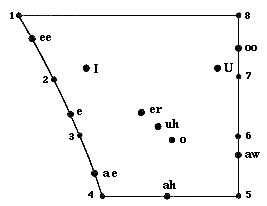The speech sound produced by the VIBRATION of the vocal cords without any closure of the vocal tract above the glottis, as is the case with a CONSONANT. Since a whispered vowel is produced without a vibration of the vocal cords, it is called a voiceless or unvoiced vowel.
The quality of the vowel sound is determined by the size and shape of the oral and nasal cavities, the former of which is largely determined by the position of the tongue and lips.
The vocal tract serves to resonate the sound produced by the vibration of the vocal cords (see RESONANCE). If it were a symmetrical tube closed at one end and open at the other, it would resonate odd HARMONICs. Instead, because of its asymmetry, the resonant frequencies broaden into FORMANT regions which can be shifted higher or lower in frequency by the tongue position and aperture of the mouth.
Vowels are characterized by at least two formant regions, and are notated in the International Phonetic Alphabet (IPA) by letters in square brackets, e.g. [i], [e], [u]. See chart under FORMANT.
See: PHONE. Compare: CONSONANT, SIBILANCE, VOCAL STOP.

The vowel quadrilateral enclosing all possible tongue positions and on whose boundaries are the cardinal vowels numbered 1 to 8.
The pure vowels in English are indicated as follows:
ee heat I hit oo cool e head ae had o ton uh the ah father er bird aw call U put
Diphthongs are vowels with shifting formant regions produced by a change in the shape of the vocal tract, in contrast to the pure vowels which are produced with a fixed vocal tract shape and tongue position. The five diphthongs in English are:
|
|
|
|
|
|
|
|
|
|
|
|
home